https://www.musical-u.com/learn/what-is-kodaly-and-how-does-it-relate-to-ear-training/
The Kodály method is for everyone; musicians 🎶 of all levels and walks of life can find something in this spirited and hands-on approach to learning music. Learn more about this method in our featured article. 😁 https://www.musical-u.com/learn/what-is-kodaly-and-how-does-it-relate-to-ear-training/
There are three elements of music: melody, harmony and rh…
https://www.musical-u.com/learn/hone-sense-rhythm/
There are three elements of music: melody, harmony and rhythm. As a musician, it’s absolutely crucial to have a firm understanding of the basics of rhythm, at the very least. But once you’ve grasped the basics, what next?
https://www.musical-u.com/learn/hone-sense-rhythm/
What did the singer just say? Have you ever experienced t…
https://www.musical-u.com/learn/the-wonderful-phenomenon-of-terrible-lyrics/
What did the singer just say? Have you ever experienced this while listening to popular music? Terrible lyrics are not a new phenomena in popular music, but an interesting topic to explore. If the lyrics are this bad, how can anyone listen to the song? Read more here: https://www.musical-u.com/learn/the-wonderful-phenomenon-of-terrible-lyrics/
What’s the value of music theory. There’s some debate amo…
https://www.musical-u.com/learn/practical-value-music-theory/
What’s the value of music theory. There’s some debate among modern musicians and songwriters about the value of learning music theory. With Dave Isaacs Guitar Studio on Music Row https://www.musical-u.com/learn/practical-value-music-theory/
Are you ready to “cut through the nonsense and sound grea…
https://www.musical-u.com/learn/free-jazz-lessons-with-steve-nixon/
Are you ready to “cut through the nonsense and sound great”? Steve Nixon at FreeJazzLessons.com has free lessons and more to suit exactly what you’re looking for. Find out more here: https://www.musical-u.com/learn/free-jazz-lessons-with-steve-nixon/
Learning to play the guitar can be fun as well as challen…
https://www.musical-u.com/learn/learning-guitar/
Learning to play the guitar can be fun as well as challenging.
Here are 6 simple tips that will help you strum your way to success. https://www.musical-u.com/learn/learning-guitar/
The Musicality Podcast: Episode 6 with Shelle Soelberg Preview
New musicality video:
Thanks for checking out this preview for the upcoming Musicality Podcast from Musical U. For updates on the podcast, please visit us at musicalitypodcast.com
===============================================
Learn more about Musical U!
Website:
https://www.musical-u.com/
Podcast:
https://www.musical-u.com/podcast-insiders/
Tone Deaf Test:
http://tonedeaftest.com/
Musicality Checklist:
https://www.musical-u.com/mcl-musicality-checklist
Facebook:
https://www.facebook.com/MusicalU
Twitter:
Tweets by MusicalU
YouTube:
https://www.youtube.com/c/MusicalU
Subscribe for more videos from Musical U!
The Musicality Podcast: Episode 6 with Shelle Soelberg Preview
TMP005
New musicality video:
Today we’re going to be talking about whole steps and half steps. musicalitypodcast.com/5
As a musician you might have heard of “whole” and “half” steps. Also known as “major and minor seconds” or “tones and semitones”. These are the building blocks of melodies, chords and all the pitches you hear in music and getting to know them in detail yourself opens up all kinds of exciting musicality potential.
Links and Resources
Jermaine Griggs interview: https://www.musical-u.com/learn/how-to-hear-and-play-with-jermaine-griggs/
Interval ear training: https://www.musical-u.com/learn/topic/ear-training/intervals/
Music Student 101: http://musicstudent101.com/
daveconservatoire.org: http://daveconservatoire.org/
What is Musicality? https://www.musical-u.com/learn/what-is-musicality/
Get extra bonuses and behind-the-scenes exclusives with Podcast Insiders. http://musicalitypodcast.com/insiders
If you enjoy the show please rate and review it! http://musicalitypodcast.com/review
Join Musical U with the Special offer for podcast listeners http://musicalitypodcast.com/join
Let us know what you think! Email: hello@musicalitypodcast.com
musicalitypodcast.com/5
===============================================
Learn more about Musical U!
Website:
https://www.musical-u.com/
Podcast:
https://www.musical-u.com/podcast-insiders/
Tone Deaf Test:
http://tonedeaftest.com/
Musicality Checklist:
https://www.musical-u.com/mcl-musicality-checklist
Facebook:
https://www.facebook.com/MusicalU
Twitter:
Tweets by MusicalU
YouTube:
https://www.youtube.com/c/MusicalU
Subscribe for more videos from Musical U!
Are you an aspiring video game 🎮 music composer who is j…
https://www.musical-u.com/learn/4-tips-composing-video-game-music/
Are you an aspiring video game 🎮 music composer who is just starting out? Look to legends like Video Game Music Academy for inspiration to creating your own compositions. 😁 https://www.musical-u.com/learn/4-tips-composing-video-game-music/
Musicality Podcast, Musicality Mindset, Lead Sheets, Hear and Play, and Whole and Half Steps
This past week, we at Musical U interrupted your regularly-scheduled programming to introduce our new brainchild – The Musicality Podcast!
What is musicality, you ask?
Simple! Musicality is a set of “inner skills” which let you freely and confidently express yourself in music.
With each episode, the Musicality Podcast will arm you with a new tool or lesson that will help you play music freely, effortlessly, and expressively. Want to learn to sight read? Improvise? Sing in tune? Want to hear the musical journeys and revelations of the most important names in music education today?
Tune in.
Podcast #1: Welcome to the Musicality Podcast
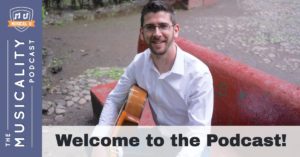 After years of playing music and never quite feeling like a natural musician, Musical U founder Christopher Sutton discovered the Pandora’s Box of natural musicianship: ear training! Wanting to introduce others to this powerful tool for tapping into their musicianship, he created Musical U in 2009.
After years of playing music and never quite feeling like a natural musician, Musical U founder Christopher Sutton discovered the Pandora’s Box of natural musicianship: ear training! Wanting to introduce others to this powerful tool for tapping into their musicianship, he created Musical U in 2009.
Our first podcast will give you the lowdown on what you can expect from the series. Here’s a little spoiler: the show won’t just cover the basics of ear training (though it will feed you a healthy dose of tips for playing by ear, developing rhythm, and improvising), but will also interview some of the most brilliant minds in music education today, allowing you to pick up some of their pointers along the way!
Podcast #2: A Mindset for Musicality
Introducing Natalie Weber: piano teacher extraordinaire and founder of the popular MusicMatters blog, a goldmine of resources related to music education.
As is common in the music world, Natalie’s first exposure to music was being dragged to piano lessons at a young age. She wasn’t immediately drawn to music. In fact, it wasn’t until years later that her love for music developed, thanks to friends who were fellow musicians and could play beautiful pieces by ear.
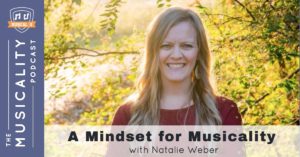 Inspired by a particularly talented friend who was able to sight-read on command and compose music on the fly with just a couple of note cues, Natalie started looking for resources that would enable her to play just as naturally. With the help of some teachers who were master improvisers, she broke through the barrier of relying on sheet music and discovered freedom with her playing.
Inspired by a particularly talented friend who was able to sight-read on command and compose music on the fly with just a couple of note cues, Natalie started looking for resources that would enable her to play just as naturally. With the help of some teachers who were master improvisers, she broke through the barrier of relying on sheet music and discovered freedom with her playing.
In our first interview podcast, Musical U chats with Natalie about her Mindset for Musicality – how she came to see music education in a creative light, and how she applies her creative approach to both her teaching and her leadership of other music teachers around the world through MusicMatters.
If you were inspired listening to Natalie, she has also written about how to motivate your students during their lessons. She has even developed a new incentive theme for her studio, which is both fun and motivating!
Another way to keep moving forward in your musical journey is to explore who other musicians look up to. No matter how successful one becomes, we all need the inspiration and guidance that can come from a mentor. On her website, Natalie linked to a fascinating piece by Practice Habits that outlines some great tactics to keep increasing your motivation in the practice room.
Podcast #3: About Playing From A Lead Sheet
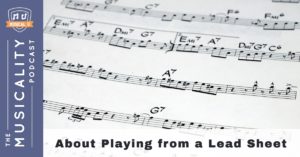 Chord charts and lead sheets are great. With their simplification of a music score, they give you the bare-bones necessities for playing a piece of music. If you’re at a decent level of sight reading, you’ll likely be able to hammer out the simple chords and melodies from these charts and sheets, and be playing the music within seconds! It’s sort of like a simplified guide to whatever piece of music you’re trying to play.
Chord charts and lead sheets are great. With their simplification of a music score, they give you the bare-bones necessities for playing a piece of music. If you’re at a decent level of sight reading, you’ll likely be able to hammer out the simple chords and melodies from these charts and sheets, and be playing the music within seconds! It’s sort of like a simplified guide to whatever piece of music you’re trying to play.
However, it’s meant to be just that: a guide. It’s up to you, the musician, to embellish and expand upon the bare-bones sheet music given to you. Lead sheets are a type of canvas that you can paint over – just be sure to stay within the lines!
In this podcast, we’ll touch upon the history of lead sheets (their beginnings were actually in jazz), how they can improve both your ear training and performing, and how you can learn to start Playing From A Lead Sheet.
Try It Out!
After learning more about lead sheets, we’re sure you’re ready to dive into learning some of your favorite songs with this simplified version of notation! Sometimes when learning to do something new, it can be good to stick with literature that you are already familiar with. Center Stage Guitar, Bass, and Ukulele Academy will walk you through the classic “Desperado” on a lead sheet.
When you get comfortable playing with this style of notation, Musician’s Unite will help you take it to the next level by improvising off a lead sheet.
Last but not least, we often talk about the importance of learning to sight read as an essential component of your overall musicality. Is this something that would apply to a lead sheet as well? Jens Larson that explains how to go about sight reading a lead sheet.
Podcast #4: How to Hear And Play, with Jermaine Griggs
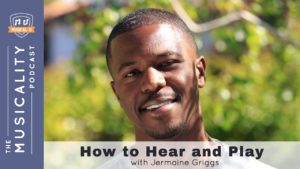 Founder Jermaine Griggs went from playing in a church, to taking on the role of music educator in his community, to launching an online company that helps countless musicians worldwide play by ear. Jermaine’s Gospel background has been an integral part of his musical journey and is a main source of the confidence that he gained as a musician.
Founder Jermaine Griggs went from playing in a church, to taking on the role of music educator in his community, to launching an online company that helps countless musicians worldwide play by ear. Jermaine’s Gospel background has been an integral part of his musical journey and is a main source of the confidence that he gained as a musician.
With Jermaine’s approach, ear training becomes intuitive, easy, and sensical.
Musical U interviewed Jermaine about his beginnings in Gospel, his approach to motivational teaching and entrepreneurship, and how he transferred his lessons in ear training to a large-scale teaching site. Find out how you, too, can learn How to Hear And Play, with Jermaine Griggs.
If you are particularly interested in Gospel music, you will enjoy his six tips for practicing difficult Gospel songs.
Hear And Play has successfully taught countless musicians around the world to play by ear, without any need for sheet music. It includes easy-to-understand lessons on the building blocks of music. For example, want to master chords? Check out “A Complete Guide to Piano Chords” from Hear and Play.
Podcast #5: About Whole Steps and Half Steps
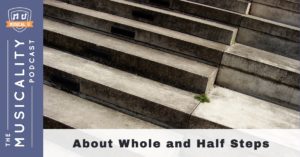 We at Musical U know that you have to walk before you can run. So prior to diving into scales and intervals, we’re going to start with the basics of ear training: half steps and whole steps.
We at Musical U know that you have to walk before you can run. So prior to diving into scales and intervals, we’re going to start with the basics of ear training: half steps and whole steps.
The half tone is the smallest interval in Western music, or the shortest distance we can have between two notes. Therefore, these are the foundation of everything from scales, modes, and intervals to chords, arpeggios, and cadences. In fact, the primary difference between major and minor scales is the order of the whole and half steps.
Friday’s podcast will be your crash course in whole steps and half steps. We’ll differentiate between steps, tones, and pitches, learn about the half step/whole step patterns in common scales, and discuss the role that these concepts play in ear training and musicality.
An important part of becoming more musical is occasionally taking a peek under the hood and spending some time understanding the mechanics, or building blocks, of what you’re doing. This introductory podcast will give those new to ear training that much-needed insight.
To learn more about whole steps, half steps, and how they build scales, read up on some helpful tips for practicing different types of scales. Or check out Pianote’s Music Theory for the Dropouts:
While you’re wrapping your head around this concept, you’ll want to also familiarize yourself with accidentals and how they relate to half and whole tones.
While most music will contain a mix of whole and half steps, 20th-century music has also incorporated the whole tone scale as a new twist on tonality. The whole tone scale is just that, only whole tones! Read more in this article from Aris Bass Blog.
Your Weekly Dose of Musicality
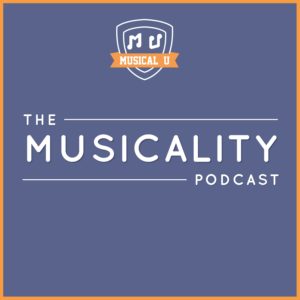 This week, we brought you crash courses in lead sheets and whole/half steps, together with two interviews with two brilliant minds in music education… And we’re just getting started. Subscribe to the Musicality Podcast, and we’ll bring you two episodes a week to introduce you to a world of skills and knowledge that will help you nurture your musicianship.
This week, we brought you crash courses in lead sheets and whole/half steps, together with two interviews with two brilliant minds in music education… And we’re just getting started. Subscribe to the Musicality Podcast, and we’ll bring you two episodes a week to introduce you to a world of skills and knowledge that will help you nurture your musicianship.
You may even discover within you a musicality you didn’t think you had.
Next week, we explore how to make the traditionally-dry topic of music theory fun, and introduce a method that will enable you to name the exact pitch of a note just by hearing it. Stay tuned!
The post Musicality Podcast, Musicality Mindset, Lead Sheets, Hear and Play, and Whole and Half Steps appeared first on Musical U.